Mauna Loa carbon dioxide forecast for 2023
Forecast of the annual rise in atmospheric carbon dioxide concentration measured at Mauna Loa, Hawaii for 2023
Carbon dioxide will continue to build up in the atmosphere in 2023 due to ongoing emissions from fossil fuel burning, land use change and cement production. However, this year's annual CO2 rise is once again predicted to be smaller than the average for 2011-2020 for the third year running, due to an extended but temporary increase in the removal of carbon from the atmosphere by tropical vegetation in response to weather conditions associated with the third consecutive year with La Niña conditions. Without the temporary effect of La Niña, the 2023 CO2 rise would have been faster than that required to track a scenario to limit global warming to 1.5°C.
We forecast the annual average CO2 concentration at Mauna Loa to be 1.97 ± 0.52 parts per million (ppm) higher in 2023 than in 2022. As a result, we forecast the 2023 annual average CO2 concentration at Mauna Loa to be 420.2 ± 0.5 ppm (Figure 1). This will be the first time in the Keeling Curve record that the annual mean CO2 level has exceeded 420 ppm. We also forecast the global annual mean CO2 concentration to be 419.2 ppm.
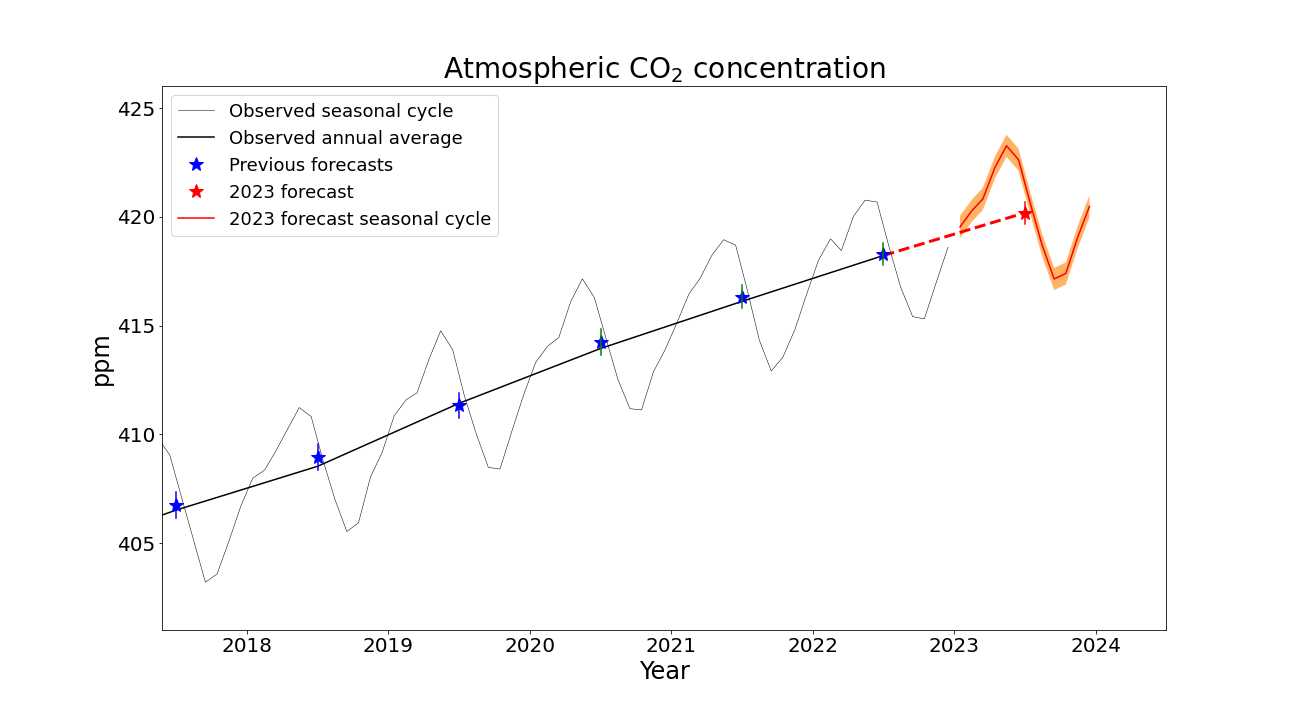
This will continue the rising trend in CO2 seen in the long-term record of measurements from the Mauna Loa observatory in Hawaii that date back to 1958. This is a good guide to the rise in global annual mean CO2 concentrations, which has typically been about 1.8 ppm below the Mauna Loa level in recent years. With the global CO2 concentration having been 417.2 ppm in 2022, this suggests a concentration of 419.2 ppm in 2023.
However, as in the previous 2 years, the rise from 2022 to 2023 will be smaller than the average annual rises over the decade of 2011-2020 (Figure 2). This is despite global emissions having returned to pre-pandemic levels after the temporary drop in 2020. Our forecast method uses total annual global emissions of 11.1 GtC, with annual emissions from fossil fuel burning and land use change estimated as 10.0 GtC and 1.1 GtC respectively, for 2022. Our prediction of a smaller atmospheric CO2 rise this year is due to natural climate variability being expected to temporarily strengthen natural carbon sinks, causing a temporary slowing of the rate of build-up of CO2 in the atmosphere.
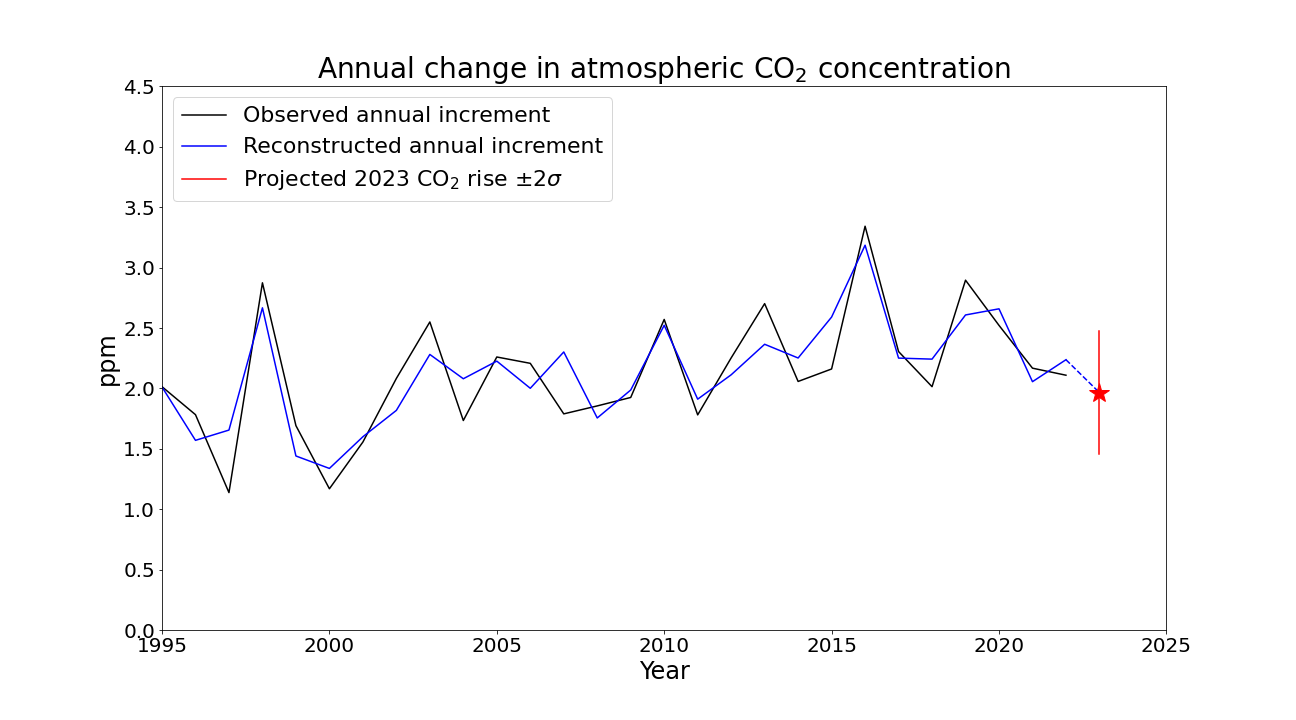
Figure 2. Annual increments (growth rate) in CO2 concentration at the Mauna Loa observatory from observations (black) and the 2023 forecast (red star). The forecast uncertainty range (red line) is ± 2 standard deviations. The blue line shows statistical reconstructions of past annual CO2 increments using the same method as used in the forecast. Observations are from the Scripps Institution of Oceanography, UC San Diego.
Specifically, this natural climate variability is the current La Niña event, marked by cooler-than-usual sea surface temperatures in the equatorial Pacific Ocean which are generally associated with modified global weather patterns that make many tropical land regions wetter and cooler. These increase plant growth, temporarily increasing the uptake of CO2 from the atmosphere and hence temporarily slowing the build-up of CO2 due to anthropogenic emissions. Although this is the third consecutive year with such conditions, this is not unprecedented and is not expected to be permanent. Once La Niña conditions cease, the tropical land carbon sink will weaken again, and the annual rate of CO2 growth will increase.
Seasonal cycle of CO2 concentrations
We also predict the maximum and minimum monthly values in the seasonal cycle of CO2 concentrations at Mauna Loa (Figure 1). Each year, the CO2 at Mauna Loa increases in the first 5 months, peaks in or around May, then declines for the next 4 months due to the uptake of CO2 by land ecosystems in the northern hemisphere growing season. Following a minimum, which is usually in September, atmospheric CO2 then increases again as autumn and winter leaf-fall and decay cause a release of CO2 back to the atmosphere. In 2023, we predict this seasonal cycle to peak at a monthly mean value of 423.3 ± 0.5 ppm in May (Figure 1, Table 1). From comparison with reconstructions of past CO2 levels from isotopes of carbon and boron in marine sediments, this will be the highest atmospheric CO2 concentration for over 2 million years.
CO2 will then return to a minimum monthly value of 417.1 ± 0.5 ppm in September before rising again.
Table 1. Forecast monthly average CO2 concentrations at Mauna Loa in 2023. The 2 standard deviations uncertainty is ± 0.5 ppm
| Month | Forecast CO2 concentration (ppm) |
|---|---|
| January | 419.5 |
| February | 420.3 |
| March | 420.8 |
| April | 422.3 |
| May | 423.3 |
| June | 422.6 |
| July | 420.6 |
| August | 418.7 |
| September | 417.1 |
| October | 417.4 |
| November | 419.1 |
| December | 420.5 |
Comparison with previous annual CO2 rises
Despite being a La Niña year with a relatively small CO2 increase compared to recent years, the central estimate of the forecast CO2 rise of 1.97 ± 0.52 ppm for 2022-2023 would be the 21st largest annual increment in the Mauna Loa record of 64 years (Figure 3). Considering the uncertainty range of ± 0.52 ppm, it would be between the 8th and 38th largest annual increments. The relatively high ranking in the series is because annual increments have been increasing over time as a result of rising anthropogenic emissions (Table 2). As a result, the rise of 1.97 ppm will be the largest annual increment on record for a La Niña event of this magnitude (Figure 4).
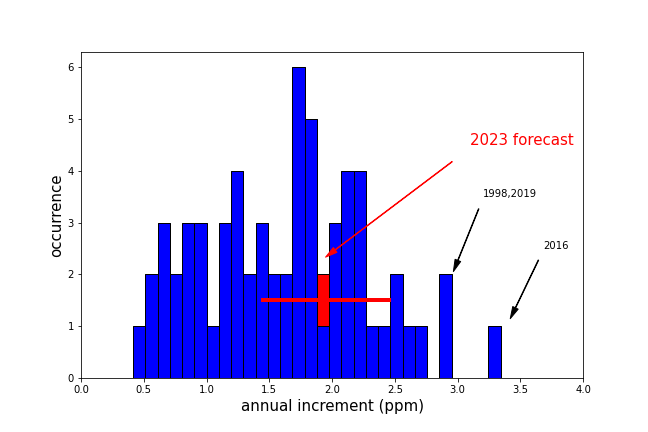 Figure 3. The central estimate of the forecast annual CO2 increment for 2022-2023 in the context of the frequency distribution of the observed annual increment for each year in the Mauna Loa record. The horizontal red bar shows the forecast uncertainty range of ± 0.52 ppm.
Figure 3. The central estimate of the forecast annual CO2 increment for 2022-2023 in the context of the frequency distribution of the observed annual increment for each year in the Mauna Loa record. The horizontal red bar shows the forecast uncertainty range of ± 0.52 ppm.
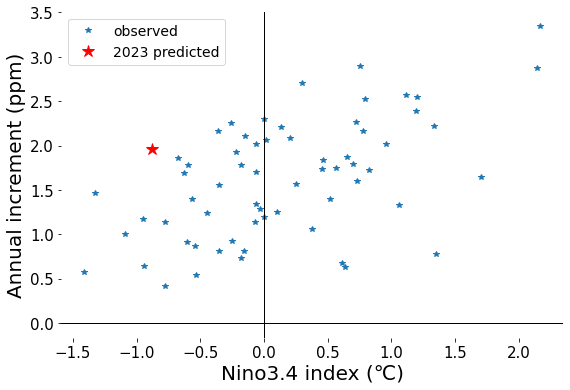
Figure 4. Annual CO2 growth rate for years 1960 to 2022 and predicted for 2023 relative to the preceding year, vs. the Niño3.4 index for April of the preceding year to March of the current year. The Niño3.4 index is the sea surface temperature (SST) anomaly in region 5°N to 5°S and 170°W to 120°W in the Pacific Ocean, de-trended to remove the effect of long-term warming.
Table 2. Decadal average CO2 rises in the Mauna Loa record
| Decade |
Average CO2 rise (ppm per year) |
|---|---|
| 1960s | 0.86 |
| 1970s | 1.22 |
| 1980s | 1.58 |
| 1990s | 1.55 |
| 2000s | 1.91 |
| 2010s | 2.41 |
Past a symbolic threshold: 50% above pre-industrial
Despite the smaller rise expected from 2022 to 2023, CO2 concentrations are still increasing and will once again reach the highest values on record. For every month of 2023, atmospheric CO2 will be at levels more than 50% higher than when humanity began large-scale burning of fossil fuels in the industrial revolution in the late 18th Century. Ice core records show that the average CO2 concentration for 1750 -1800 was 278 ppm. 2022 was the first year with the annual average CO2 at more than 50% above this (417 ppm), although in some months the level was below this. 2023 will be the first year with monthly CO2 consistently above this level.
This 50% increase above pre-industrial is of symbolic importance because it represents half-way towards "doubled CO2", a standard level of climate forcing used for quantifying the response of global temperatures to human-caused increases in greenhouse gases. Although "halfway to doubled CO2" is not of any physical significance, it can nevertheless be considered a milestone that highlights how much humans have already altered the composition of the global atmosphere and increased the amount of a gas that warms the global climate.
Contributions of anthropogenic emissions and varying natural carbon sinks to the CO2 rise
Long-term increases in observed CO2 are entirely the result of human-caused emissions of carbon dioxide into the atmosphere – more than enough CO2 has been emitted by fossil fuel burning, cement production and deforestation to account for the increase measured in the atmosphere. Although CO2 concentrations have now increased by just over 50% since the industrial revolution, this increase would have been almost twice as large if some CO2 had not been removed from the atmosphere through being absorbed by plants and the oceans.
These natural sinks of carbon vary in strength from year to year as a result of short-term fluctuations in climate, principally through El Niño Southern Oscillation (ENSO) cycles in the Tropical Pacific Ocean. The annual CO2 rise is faster during El Niño conditions and slower during La Niña conditions. The Met Office CO2 forecast therefore takes account of both anthropogenic emissions and the impacts of climate variability on natural carbon sinks. So far, including the effect of ENSO variability has in all years brought the central value of the CO2 rise forecast closer to the observations than when considering anthropogenic emissions alone (Figure 5).
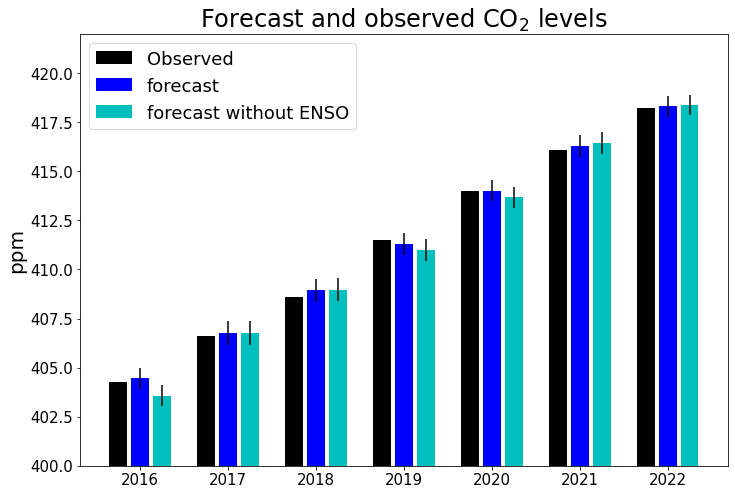
Figure 5. Observed (black) and forecast (dark blue) annual average CO2 concentrations for 2016 to 2022, and re-forecast values based on emissions alone, without the effects of ENSO (light blue). Thin black lines show the forecast uncertainty range (2 standard deviations).
Impact of La Niña on the forecast CO2 rise in 2023
We can estimate the potential contribution of La Niña conditions to the CO2 rise forecast for 2023 by repeating our forecast calculation without the sea surface temperature change, ie: with "neutral" conditions. This suggests that without a La Niña response in the atmosphere and tropical land ecosystems, the forecast annual mean CO2 rise from 2022 to 2023 would be 2.32 ppm, a faster rise than the 1.97 ppm forecast when accounting for La Niña (Table 3).
Similary, the annual CO2 rises 2020/21 and 2021/22 would have also been higher if La Niña conditions had not been present (Table 3). Although the observed annual CO2 rise appears to have declined over the last 3 years, the rise calculated without the effects of La Niña shows an increase over that time, consistent with the emissions. This shows that for short periods, the observed rate of build-up of CO2 in the atmosphere does not necessarily reflect the changes in emissions – the effects of climate variability on the short-term rise can dominate. However, in the longer term, the ongoing increase in the annual rate of CO2 rise is quite evident despite large interannual variability (Figure 6). When the effects of ENSO are removed, the calculated CO2 rise shows an ongoing increase.
Table 3. Annual emissions and the resulting mean CO2 increment for 2021-2022 calculated with and without La Niña sea surface temperatures (SSTs). The increment is shown both in parts per million (ppm) and gigatonnes of carbon (GtC) to allow comparison with the emissions.
| Year | Annual emissions | Annual CO2 increment with La Niña SSTs | Annual CO2 increment with neutral SSTs |
|---|---|---|---|
| 2021 | 10.51 GtC | 2.17 ppm (4.61 GtC) | 2.20 ppm (4.67 GtC) |
| 2022 | 10.98 GtC | 2.11 ppm (4.48 GtC) | 2.30 ppm (4.88 GtC) |
| 2023 | 11.1 GtC | 1.97 ppm (4.18 GtC) | 2.32 ppm (4.93 GtC) |
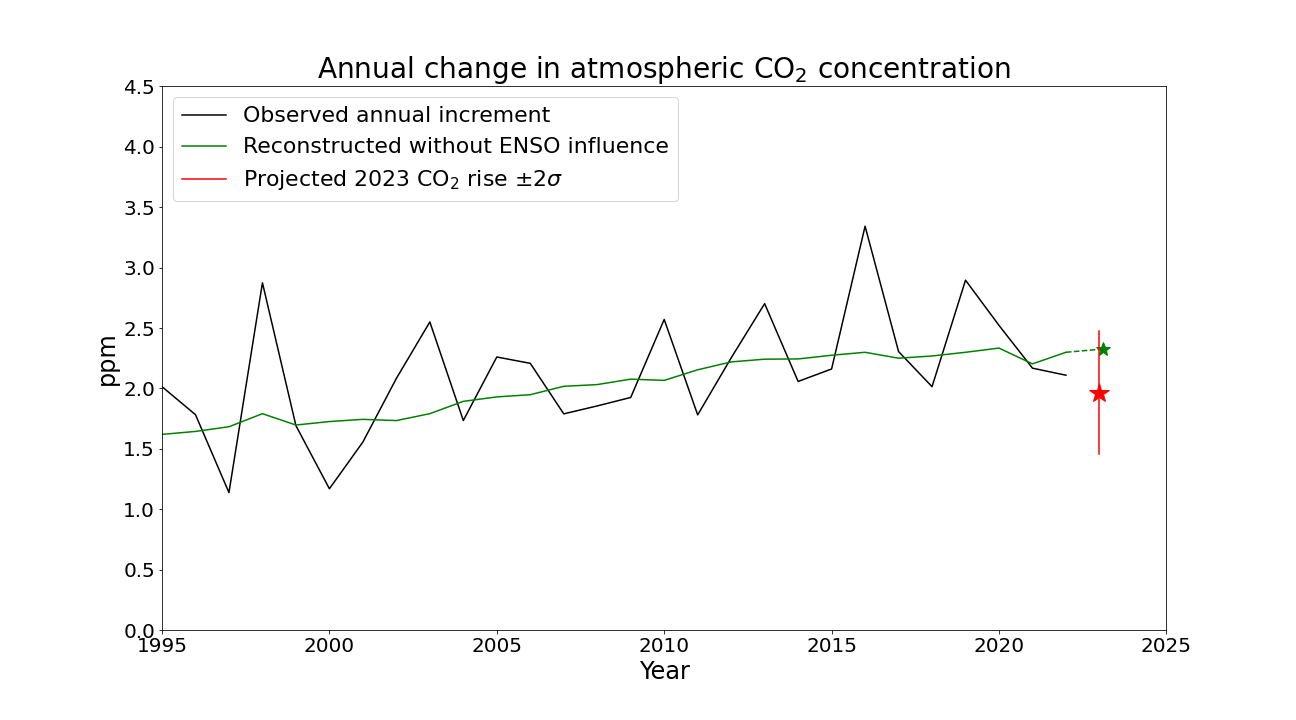
Figure 6: Annual increments (growth rate) in CO2 concentration at the Mauna Loa observatory from observations (black) and the 2023 forecast (red star), and the estimated increments without the influence of ENSO (green). The forecast uncertainty range (red line) is ± 2 standard deviations. Observations are from the Scripps Institution of Oceanography, UC San Diego.
Comparison with CO2 trajectory consistent with limiting global warming to 1.5°C
The Paris Agreement commits nations to pursuing efforts to limit the rise in global temperatures to 1.5°C above pre-industrial levels, and model calculations suggest that achieving this would require the rise in atmospheric CO2 to slow rapidly within the next few years and cease completely within the next two decades. Figure 7 shows one example of such a scenario, the IPCC's "C1-IMP-LD" scenario which features low demand for energy - other trajectories could also be followed, but all requires the rise in CO2 to rapidly reach zero. This scenario can provide a benchmark against which the observed atmospheric CO2 rise can be compared as part of assessing progress towards the Paris Agreement goal.
Although this year's slower rise (red star) is within the 1.5°C scenario (grey plume), this is only because of the enhanced carbon sinks due to La Niña conditions which will be temporary. When the effects of La Niña are excluded (green star) the anthropogenic emissions would be causing the CO2 rise in 2023 to be above the rate required to track the 1.5°C scenario.
If atmospheric CO2 concentrations are to follow the C1-IMP-LD scenario limiting global warming to 1.5°C, the average CO2 rise over the 2020s would need to be more than 30% lower than the annual rise forecast here for 2023 (Table 4). This would only be achievable by immediate and substantial cuts in global CO2 emissions.
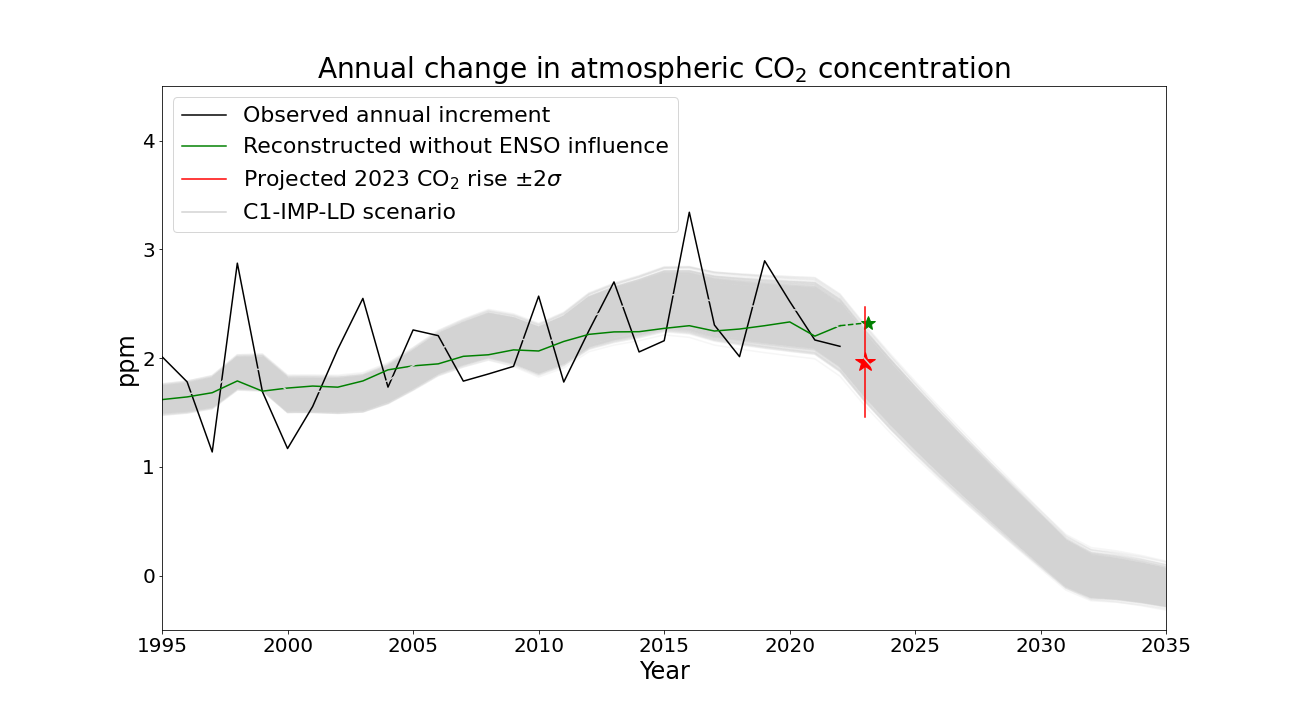
Figure 7. Comparison of recent and forecast annual CO2 increments with scenario limiting global warming to 1.5°C. Black: Annual increments in CO2 concentration at the Mauna Loa observatory from observations. Red star: the 2023 forecast increment. Green: Estimated increments without the influence of ENSO. Grey plume: simulated CO2 concentrations in scenario limiting global warming to 1.5°C.
Table 4. Decadal average CO2 rises in the C1-IMP-LD scenario for limiting global warming to 1.5° with little or no overshoot (IPCC 2022).
| Decade |
Average CO2 rise (ppm per year) |
|---|---|
| 2020s | 1.33 |
| 2030s | -0.14 |
|
2040s |
-0.53 |
| 2050s | -0.65 |
Verification of previous CO2 forecasts
The technique used to make this forecast was also used to make forecasts ahead of time for 2016, 2017, 2018, 2019, 2020, 2021 and 2022. In 2020 we also issued an updated forecast once it became clear that the response to the Covid-19 pandemic would cause global CO2 emissions to be much smaller than expected that year.
Our usual methodology uses a statistical relationship between the annual CO2 rise, human-caused emissions and changes in sea surface temperature (SST) in the equatorial Pacific Ocean as a measure of the strength of the dominant pattern of natural climate variability that is known to affect the strength of carbon sinks. We use an average of SSTs from ocean observations in recent months and seasonal forecasts for the coming months.
From 2016 to 2019, our forecast calculations used the annual emissions from the previous year as published in the Global Carbon Budget, as normally the ongoing trend in emissions is not large enough to affect the forecast substantially. Our original forecast for 2020 also made this assumption, while our revised 2020 forecast included an adjustment based on projected emissions profiles across the year applied to an atmospheric transport model. Our forecast for 2021 assumed that global emissions had returned to approximately 2019 levels, having already returned to near those levels at the end of 2020. Our forecast for 2022 used the fossil fuel emissions for 2019 and land use emissions from 2020. Our forecast for 2023 has returned to the usual method of using Global Carbon Budget emissions from the previous year, ie: 2022.
Table 5 compares the 2022 forecasts of annual average CO2 rise and annual CO2 concentrations with measurements at Mauna Loa, along with forecasts and observations from previous years. As with previous years, the 2021 forecast agreed with observations within the forecast uncertainty (2 standard deviations).
Table 5. Summary of forecast and observed annual CO2 concentrations and rises for 2016 to 2022. Note that observations are not available from 28th November 2022 onwards due to the eruption of the Mauna Loa volcano cutting off power supplies to the observatory, so for 2022 the comparison of forecast and observed mean concentration is given for January-November, and the forecast and observed increases are calculated relative to the January-November mean for 2021. For 2020, both the original forecast and the updated forecast accounting for the Covid-related emissions reductions are shown.
| Year | Forecast CO2 increase from previous year (ppm) | Observed CO2 increase from previous year (ppm) | Forecast annual mean CO2 concentration (ppm) | Observed annual mean CO2 concentrations (ppm) |
|---|---|---|---|---|
| 2022 (Jan-Nov) | 2.14 ± 0.52 | 2.10 | 418.25 | 418.19 |
|
2022 (Annual) |
2.14 ± 0.52 | Not available | 418.3 ± 0.5 | Not available |
| 2021 | 2.29 ± 0.55 | 2.10 | 416.3 ± 0.6 | 416.1 |
| 2020 (updated) | 2.48 ± 0.57 | 2.52 | 414.0 ± 0.6 | 414.0 |
| 2020 (original) | 2.74 ± 0.57 | 2.52 | 414.2 ± 0.6 | 414.0 |
| 2019 | 2.74 ± 0.58 | 2.90 | 411.3 ± 0.6 | 411.5 |
| 2018 | 2.29 ± 0.59 | 2.00 | 408.9 ± 0.6 | 408.6 |
| 2017 | 2.46 ± 0.61 | 2.31 | 406.8 ± 0.6 | 406.6 |
| 2016 | 3.15 ± 0.53 | 3.39 | 404.5 ± 0.6 | 404.3 |
Figure 8 and Table 6 compare the 2022 forecast with observations for each month. In our forecast we had assigned the same uncertainty to monthly and annual values, but this ignores the role of within-year impacts such as periods of fire activity in areas not typically affected by ENSO, or anomalous wind directions at the measurement site at Mauna Loa. Quantification of these additional sources of uncertainty at monthly levels are a topic of ongoing research and our stated uncertainty on the monthly averages will therefore be an underestimate.
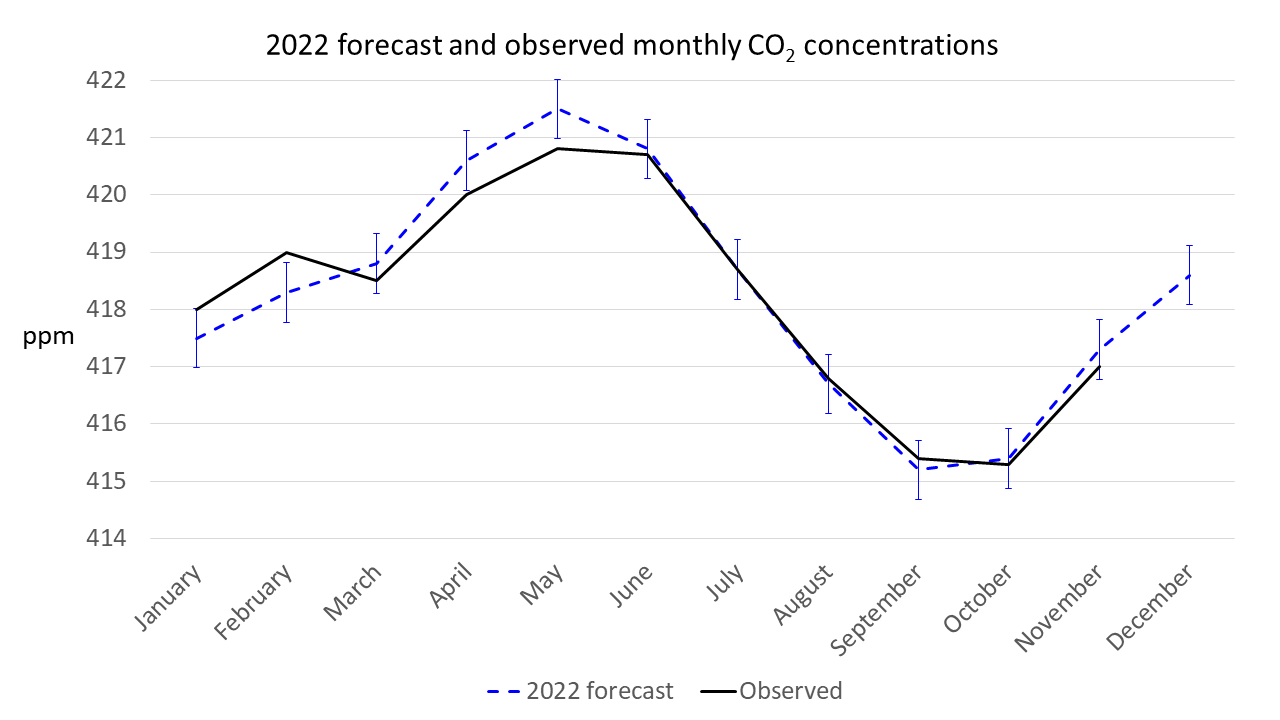
Figure 8. Comparison of Met Office forecasts of monthly CO2 concentrations in 2022 at Mauna Loa (dashed blue line) with measurements for 2022 (solid black line) from the Scripps Institution for Oceanography UC San Diego. Measurements are only available until 28 Nov. The vertical blue lines show the forecast uncertainty range (2 standard deviations).
Table 6. Forecast and observed monthly average CO2 concentrations at Mauna Loa over 2022. The uncertainty in the forecast values was ±0.5 ppm. Observed monthly averages for January to October are those published by the Scripps Institution for Oceanography at UC San Diego. The observed monthly value for November is the mean of daily values up to 27th November posted on social media by the Scripps Institution for Oceanography. Observations at Mauna Loa are not available from 28th November onwards.
| Month | Forecast (ppm) | Observations (ppm) |
|---|---|---|
| January | 417.5 | 418.0 |
| February | 418.3 | 419.0 |
| March | 418.8 | 418.5 |
| April | 420.6 | 420.0 |
| May | 421.5 | 420.8 |
| June | 420.8 | 420.7 |
| July | 418.7 | 418.7 |
| August | 416.7 | 416.8 |
| September | 415.2 | 415.4 |
| October | 415.4 | 415.3 |
| November | 417.3 | 417.0 |
| December | 418.6 | Not available |
Note: definitions of annual CO2 rise, increment and growth rate
We define the annual CO2 rise or annual increment for a particular year as the difference in annual average concentration for that calendar year and that of the previous calendar year. This is different to the definition of annual 'growth rate' as published by NOAA which is the average change across an individual calendar year.
Published 26th January 2022



